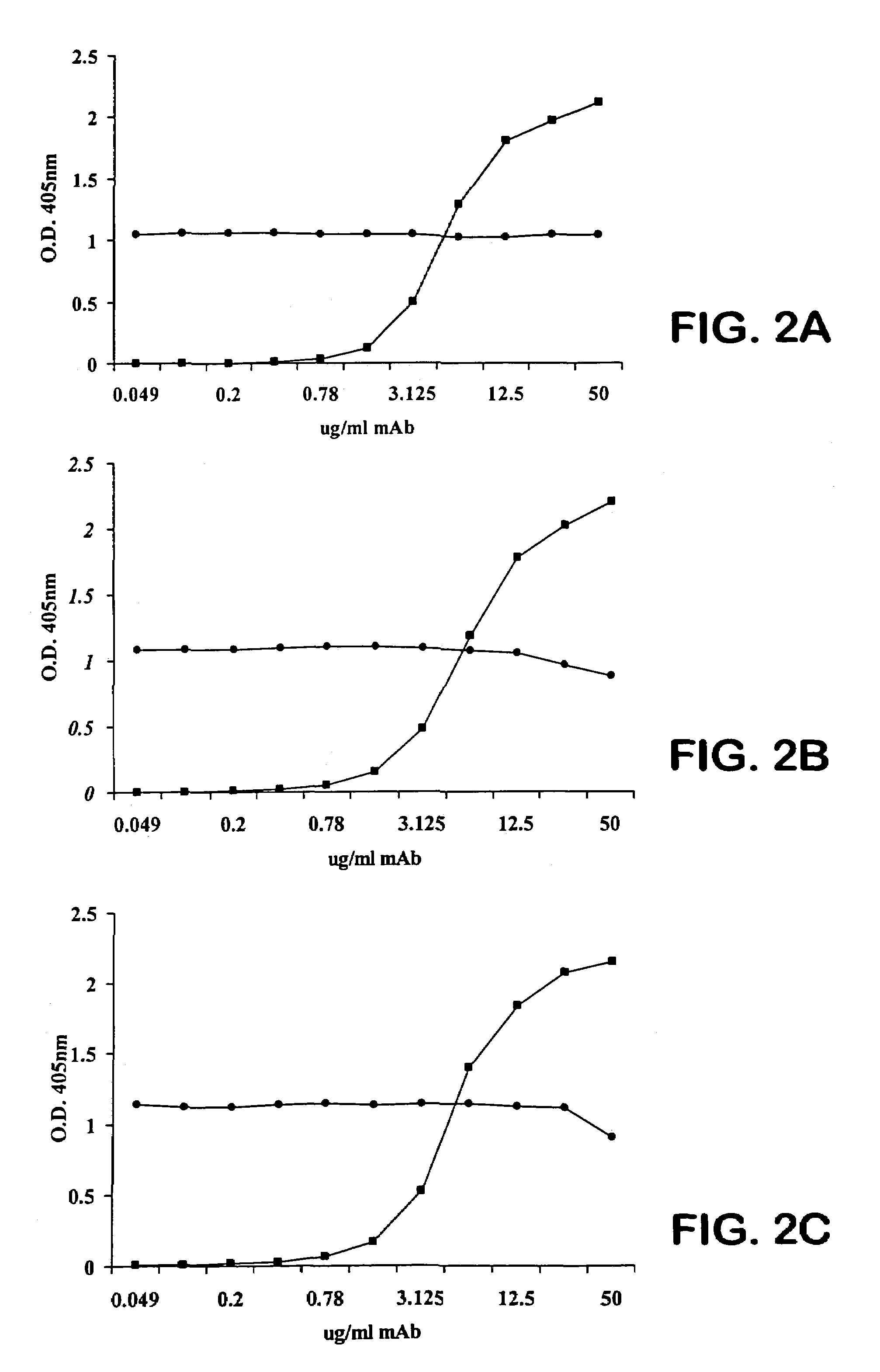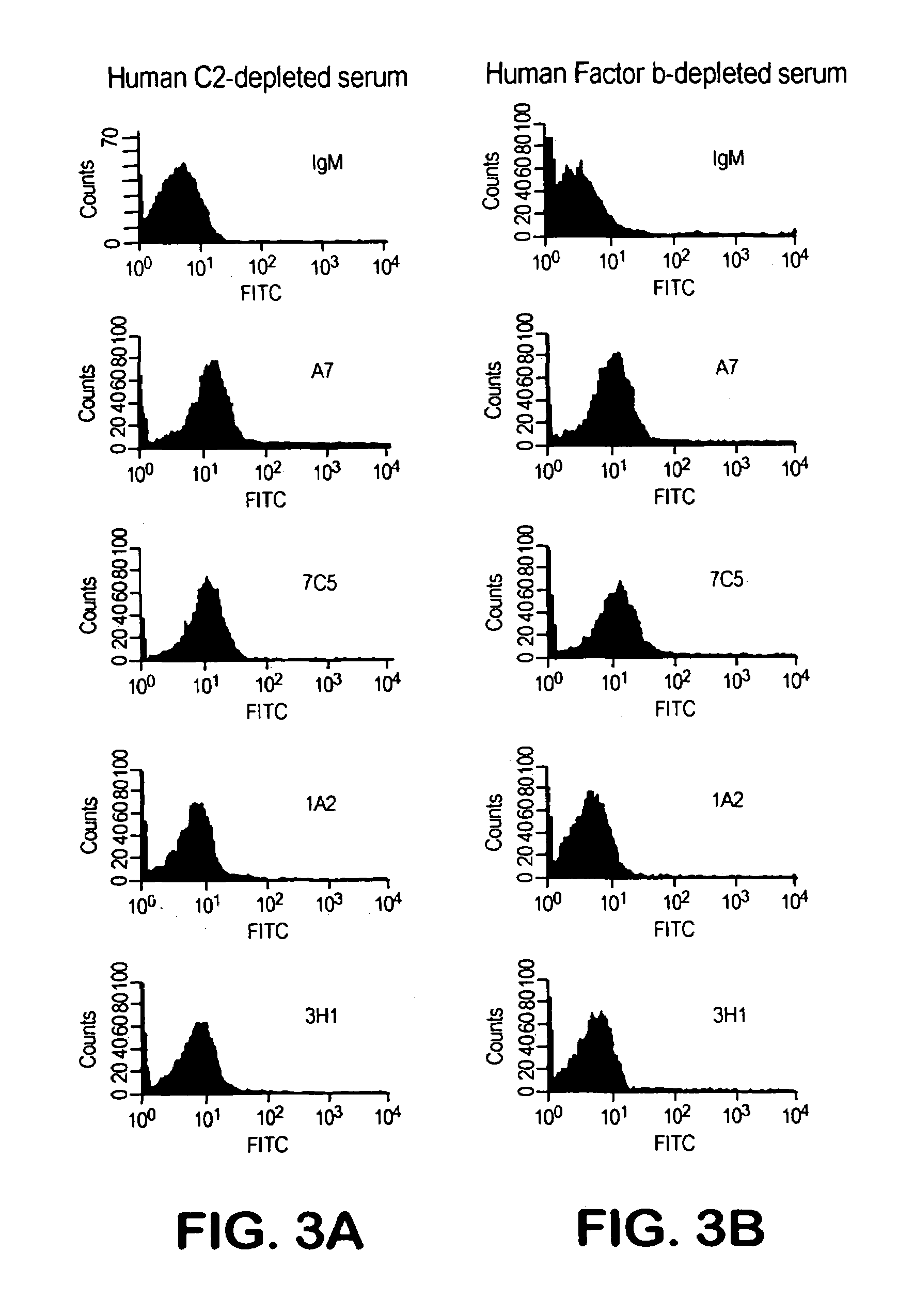Human antipneumococcal antibodies from non-human animals
a technology non-human animals, which is applied in the field of human antipneumococcal antibodies from non-human animals, can solve the problems of human morbidity and mortality, poor immunogenicity of pps in many individuals, and poor immunogenicity of pps in infants
- Summary
- Abstract
- Description
- Claims
- Application Information
AI Technical Summary
Benefits of technology
Problems solved by technology
Method used
Image
Examples
example 1
Generation of Monoclonal Antibodies to Strevtococcus pneumoniae Capsular Polysaccaride (PPS-3)
[0125]We vaccinated transgenic mice comprising human immunoglobulin loci (XenoMouse™; Mendez et al., Nat. Genet. 15, pp. 146–56 (1997)) with a S. pneumoniae PPS-3 conjugate produced from purified PPS-3 (Strain 10813, ATCC). See, e.g., Russell et al., Infection Immunity 68:1820–26 (2000). In this experiment, we used PPS-3-Tetanus toxoid conjugate (PPS-3-TT) and, as a control, we vaccinated XenoMouse™ mice with commercially available TT. We vaccinated the XenoMouse™ mice subcutaneously at the base of the tail with a total dose of 2.5 μg of PPS-3-TT or TT. We isolated splenocytes from the vaccinated XenoMouse™ mice at 7 or 14 days after vaccination and generated hybridomas by fusion of splenocytes with mouse myeloma cell line NSO and propagated the cells using ClonaCell™-HY (Stem Cell Technologies Inc., Vancouver, Canada) according to the manufacturer's instructions.
[0126]We then tested the ap...
example 2
Characterization of Mabs to S. pneumoniae PPS-3
[0128]We designated four of the human Mabs from these hybridomas as 1F10 / 7C5, 3H11, 1A2 and A7. Each of these Mabs was IgM and reacted with PPS-3 and SPA but did not exhibit significant binding to TT, BSA, CWPS or dsDNA.
[0129]We determined whether the antibodies were specific for PPS-3. We performed an ELISA by coating plates with 10 μg / ml PPS-3, adding 5 μg / ml of Mabs 1F10 / 7C5, 3H11, 1 A2 and A7 and monitoring the ability of increasing concentrations (0.1–100 μg / ml) of soluble PPS-3 to inhibit antibody binding. We also performed the reverse assay where we added a fixed amount of the biotinylated Mab to serial dilutions of unlabeled Mabs and incubated in PPS-3-coated plates. In both cases, we also incubated the plates without inhibitor as a positive control. We detected the binding of biotinylated Mab by adding HRP-labeled steptavidin and developing with perokidase substrate (Kirkegaard & Perry Laboratories). We measured the optical den...
experiment 3
Epitope Specificity
[0131]We perform competitive-binding assays to compare the epitope specificity of the Mabs. We biotinylate one test Mab by determining the molar concentration of the Mab and preparing an 0.1 M solution of EZ-link sulfo-NHS-LC Biotin (Pierce, Rockford, Ill.) with N,N-dimethylformamide (DMF; Aldrich, Milwaukee, Wis.). We then slowly add 1 mg biotin while simultaneously vortexing the solution. We incubate the reaction for 1 hour at room temperature and then dialyze the biotinylated Mab overnight into PBS. We perform ELISA binding curves of each Mab on PPS-3-coated plates to determine the concentration of biotinylated Mab that results in 50% saturation and to confirm that the biotinylated Mab binds PPS-3 similarly to unlabeled Mab.
[0132]For competition experiments, we add each of the other Mabs at the concentration that results in 50% saturation to equal volumes of dilutions of the biotinylated test Mab and incubate with PPS-3-coated ELISA plates. We also perform the ...
PUM
| Property | Measurement | Unit |
|---|---|---|
| concentrations | aaaaa | aaaaa |
| concentrations | aaaaa | aaaaa |
| molar concentration | aaaaa | aaaaa |
Abstract
Description
Claims
Application Information
 Login to View More
Login to View More - R&D
- Intellectual Property
- Life Sciences
- Materials
- Tech Scout
- Unparalleled Data Quality
- Higher Quality Content
- 60% Fewer Hallucinations
Browse by: Latest US Patents, China's latest patents, Technical Efficacy Thesaurus, Application Domain, Technology Topic, Popular Technical Reports.
© 2025 PatSnap. All rights reserved.Legal|Privacy policy|Modern Slavery Act Transparency Statement|Sitemap|About US| Contact US: help@patsnap.com



